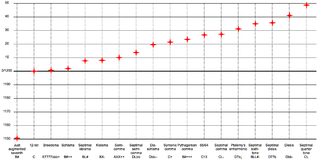
In Western musical notation, a key signature is a set of sharp, flat, or rarely, natural symbols placed on the staff at the beginning of a section of music. The initial key signature in a piece is placed immediately after the clef at the beginning of the first line. If the piece contains a section in a different key, the new key signature is placed at the beginning of that section.

The major scale is one of the most commonly used musical scales, especially in Western music. It is one of the diatonic scales. Like many musical scales, it is made up of seven notes: the eighth duplicates the first at double its frequency so that it is called a higher octave of the same note.
In music theory, the minor scale is three scale patterns – the natural minor scale, the harmonic minor scale, and the melodic minor scale – mirroring the major scale, with its harmonic and melodic forms
In music theory, the key of a piece is the group of pitches, or scale, that forms the basis of a musical composition in Western classical music, art music, and pop music.
Tonality or key: Music which uses the notes of a particular scale is said to be "in the key of" that scale or in the tonality of that scale.

In modern musical notation and tuning, an enharmonic equivalent is a note, interval, or key signature that is equivalent to some other note, interval, or key signature but "spelled", or named differently. The enharmonic spelling of a written note, interval, or chord is an alternative way to write that note, interval, or chord. The term is derived from Latin enharmonicus, from Late Latin enarmonius, from Ancient Greek ἐναρμόνιος (enarmónios), from ἐν (en) and ἁρμονία (harmonía).
In music, sharp, dièse, or diesis means, "higher in pitch". More specifically, in musical notation, sharp means "higher in pitch by one semitone ". Sharp is the opposite of flat, which is a lowering of pitch. The ♯ symbol itself is conjectured to be a condensed form of German ligature ſch or the symbol ƀ.

In music theory, the circle of fifths is a way of organizing the 12 chromatic pitches as a sequence of perfect fifths.. If C is chosen as a starting point, the sequence is: C, G, D, A, E, B, F♯, C♯, A♭, E♭, B♭, F. Continuing the pattern from F returns the sequence to its starting point of C. This order places the most closely related key signatures adjacent to one another. It is usually illustrated in the form of a circle.
C-flat major is a major scale based on C♭, consisting of the pitches C♭, D♭, E♭, F♭, G♭, A♭, and B♭. Its key signature has seven flats. Its relative minor is A-flat minor. Its parallel minor, C-flat minor, is usually replaced by B minor, since C-flat minor's three double-flats make it impractical to use. The direct enharmonic equivalent of C-flat major is B major, a key signature with five sharps.
A major is a major scale based on A, with the pitches A, B, C♯, D, E, F♯, and G♯. Its key signature has three sharps. Its relative minor is F-sharp minor and its parallel minor is A minor. The key of A major is the only key where the Neapolitan sixth chord on (i.e. the flattened supertonic) requires both a flat and a natural accidental.
F-sharp major is a major scale based on F♯, consisting of the pitches F♯, G♯, A♯, B, C♯, D♯, and E♯. Its key signature has six sharps.
A-flat major is a major scale based on A♭, with the pitches A♭, B♭, C, D♭, E♭, F, and G. Its key signature has four flats.
D-flat major is a major scale based on D♭, consisting of the pitches D♭, E♭, F, G♭, A♭, B♭ and C. Its key signature has five flats. It is enharmonically equivalent to C-sharp major.
G-flat major is a major scale based on G♭, consisting of the pitches G♭, A♭, B♭, C♭, D♭, E♭, and F. Its key signature has six flats.

G-sharp minor is a minor scale based on G♯, consisting of the pitches G♯, A♯, B, C♯, D♯, E, and F♯. Its key signature has five sharps.
D-sharp minor is a minor scale based on D♯, consisting of the pitches D♯, E♯, F♯, G♯, A♯, B, and C♯. Its key signature has six sharps.
F minor is a minor scale based on F, consisting of the pitches F, G, A♭, B♭, C, D♭, and E♭. Its key signature consists of four flats. Its relative major is A-flat major and its parallel major is F major. Its enharmonic equivalent, E-sharp minor, has six sharps and the double sharp F, which makes it impractical to use.
A-flat minor is a minor scale based on A♭, consisting of the pitches A♭, B♭, C♭, D♭, E♭, F♭, and G♭. Its key signature has seven flats. Its relative major is C-flat major, its parallel major is A-flat major, and its enharmonic equivalent is G-sharp minor.
In music theory, a theoretical key is a key whose key signature would have at least one double-flat or double-sharp.

Hungarian Rhapsody No. 2 in C-sharp minor, S.244/2, is the second in a set of 19 Hungarian Rhapsodies by composer Franz Liszt, and is by far the most famous of the set.
G-sharp major is a theoretical key based on the musical note G♯, consisting of the pitches G♯, A♯, B♯, C♯, D♯, E♯, and F. Its key signature has six sharps and one double sharp.





